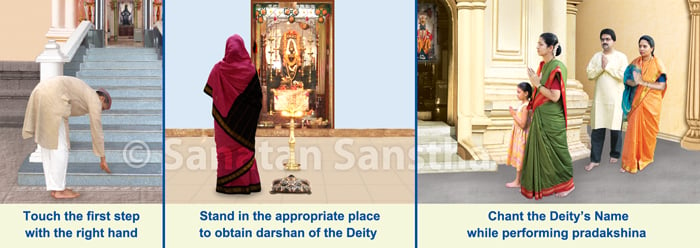
Most of us go to the temple in order to take darshan (viewing) of a Deity. Did you know that we can derive maximum benefit from the darshan, if we were to take note of some actions which should be performed as prescribed by Hindu Dharma while visiting a Devalay? There is a science underlying most of these actions. These actions that should be performed while visiting a Devalay are listed elaborated in the article below.
1. Prayer to be made at home before leaving for a Devalay
‘O ____ (Name of the Deity), only due to the inspiration provided by you, I am able to come for your darshan. Let me have your darshan with bhav (Spiritual emotion).’
2. Gratitude to be expressed after reaching the Devalay
‘O ____ (Name of the Deity), you only have given me the opportunity to have your darshan; hence, I express gratitude at your Holy feet.’
3. Actions required to be performed before entering a Devalay
3A. Leather objects worn should be removed and kept aside.
3B. Footwear like shoes and sandals should not be worn inside the Devalay premises. If this is not possible or if the Devalay is next to a road, then enter the Devalay after praying for forgiveness. If footwear is to be removed inside the premises or outside the Devalay, then it should be removed to the right side of the Deity.
3C. If there is a facility in the Devalay, feet should be washed.
3D. After washing the feet, take some water in the right palm, and reciting ‘अपवित्रः पवित्रो वा’, sprinkle the water thrice over your body.
3E. Do not cover your neck with a cloth.
3F. If there is a custom of removing the upper-body garment (like a shirt) by males before entering a Devalay, then it should be followed. (This may not appear practical, yet the custom is followed to retain the sattvikta of the Devalay.)
3G. While visiting a Devalay for darshan, ordinary male-devotees should wear topi (Bharatiya cap, used especially during rituals) or tie a Holy cloth on the head, whereas female-devotees should cover their head with pallu (Free end of a sari, normally worn over the shoulder). Males-females with a spiritual level above 50% need not cover their head. In this regard, follow the prevalent tradition.
3H. Pay obeisance to the main entrance door and Garuda-dhwaj (Sentinel flag) of the Devalay.
3I. Prayers to be done before entering a Devalay
3I1. While entering the Devalay pray that – ‘O ____ (Name of the Deity), let my mind not wander, let it concentrate on chanting. Through your grace, let me be able to absorb maximum of the sattvikta present here.’
3I2. ‘O ____ (Name of the Deity), it is because of your grace that I am entering the Devalay. Let me be blessed with your darshan. Let there be an improvement in my chanting. Let me be able to avail of the sattvikta present there.’
4. Once inside the Devalay premises, have darshan of the kalash (Dome of a temple) of the Devalay and pay obeisance to it.
5. While standing in a queue, avoid chatting with the people around
If the Devalay is crowded, form a queue. While proceeding for darshan keep chanting. This will help imbibe sattvikta to a greater extent. Avoid chatting with the people around at that time.
6. Proceeding towards the sabhamandap (Hall in a temple) from the premises
6A. While proceeding towards the sabhamandap (Hall), hold the hands in Namaskar-mudra. (Both the hands joined and held at the level of the Anahat-chakra ([The fourth centre in the spiritual energy flow system, located in the region of the heart in the subtle-body Note 1)], but a little away from the body.)
(Note1 : Anahat-chakra – The fourth centre in the spiritual energy flow system, located in the region of the heart in the subtle body.)
6B. At that time, the bhav should be as if we are going to visit our revered Guru or the Deity and that ‘Our Guru or Deity is looking at us.’
7. Climbing the steps of a Devalay
While climbing the steps of a Devalay, touch the steps with the fingers of the right hand and then touch that hand to the Adnya-chakra (Sixth centre or chakra in the spiritual energy system; located in the mid-brow region in the subtle-body).
8. Entering the sabhamandap
8A. Before entering the sabhamandap, do Namaskar to the entrance door of the sabhamandap from a distance.
8B. While climbing the steps of a Devalay, touch the steps with the fingers of the right hand and then touch that hand to the Adnya-chakra.
8C. While stepping inside the sabhamandap pray thus – ‘O Deity, let me benefit from the Chaitanya (Divine consciousness) being emitted by your Idol to the utmost’.
9. Proceeding from the sabhamandap towards the garbha-gruha (Sanctum sanctorum of a temple)
Insert figure page 25
9A. Walk along the left side of the sabhamandap towards the garbha-gruha (Sanctum-sanctorum). (After darshan of the Deity while returning, walk along the right side of sabhamandap.)
9B. If you have to stand in a queue for the darshan, then instead of chatting with the people around, concentrate on chanting.
10. Actions to be performed before having darshan of the Deity
10A. As far as possible, avoid ringing the bell. If you wish to ring it, do so in a very low tone.
10B. Before having darshan of the pindi (Deity Shiva’s sacred symbol) in a Shiva Devalay, have darshan of Nandi by touching both its horns. This is known as Shrungadarshan. The correct method of Shrungdarshan is – We should sit or stand to the right side of Nandi and place our left hand on Nandi’s testicles. We should place the forefinger (the finger next to the thumb) and the thumb on the two horns of Nandi. Then, we should view the linga (Deity Shiva’s sacred symbol) through the frame thus created by the finger, thumb and the horns.
10C. Entering a garbha-gruha is mostly prohibited. However, in some Devalays it is permitted. At such times, before entering the garbhagruha we should do Namaskar to Shri Gaṇnapati and Shri Kirtimukh.
11. Actions to be performed while having darshan of the Deity’s Idol
11A. To have darshan of the Deity, do not stand or sit in the space between the Deity’s Idol and the Idol of tortoise or the pindi and Nandi in a Shiva Devalay; stand on the side of the line joining the Idol of the tortoise or Nandi with the Idol of the Deity or pindi.
11B. In the first stage, focus your attention at the feet of the Idol and with emotion of complete surrender, pray for the dissolution of the ego. In the second stage, concentrate at the chest level of the Idol, that is, at the Anahat-chakra and pray intensely. In the third and the last stage, concentrate on the eyes of the Deity and store the Deity’s image in your eyes.
11C. Pay obeisance to the Deity with an emotion of complete surrender at the Deity’s feet. During the act, males should not cover their head (remove whatever you are wearing on the head), while females should cover their head.
12. Actions to be performed after having darshan of the Deity
From the perspective of imbibing maximum of the Deity’s Principle while inside a Devalay, the ancient Devalays had an ideal design. Such ideal Devalays used to have a garbhagar (Anteroom), a space joining the sabhamandap and garbha-gruha. So also the Yadnyakundda (Pit for the sacrificial fire) used to be on the right side of garbha-gruha, while the Devalay of Deity Suryanarayann used to be on the left side. (Please see the figure ahead). Such Devalays can still be seen in Goa.
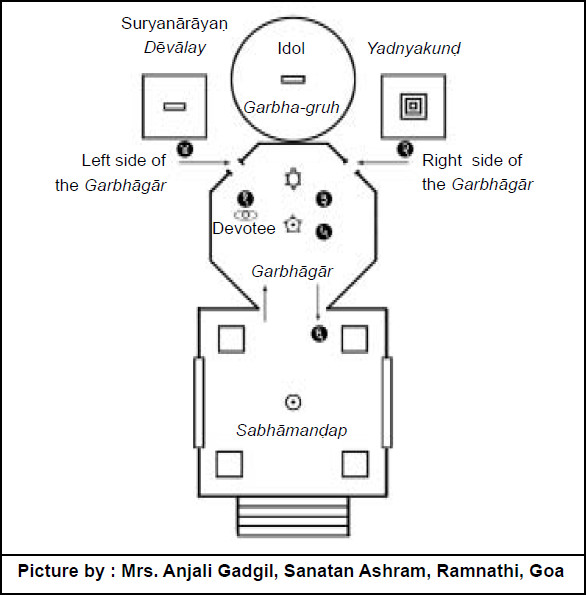
12A. Come out through the door on the right side of the garbhagar and have darshan of the Fire Deity, meaning, the mandap (Hall) containing the Yadnyakunda.
12B. Then, enter the garbhagar again and coming out of the door onto your left, have darshan of the Idol of Deity Suryanarayann (if there is one).
12C. Once again enter the garbhagar, have darshan of the main Deity and exit from the main door.
Numbers 1 to 6 show the pathway to be followed while having darshan.
13. Performing pradakshinna (Circumambulation) of the Deity
13A. Commence the pradakshina (Circumambulation) after standing on the left side outside the garbha-gruha. (On completion of the pradakshina, stand on the right side and have darshan.)
13B. Before starting the pradakshina, pray to the Deity thus – ‘O ____ (Name of the Deity), as I perform the pradakshina by your grace, with every step let all the sins of my past births burn away and let me be able to imbibe more and more of the Chaitanya emitting from you.’
13C. Perform pradakshina at a medium pace with the hands joined together in a Namaskar-mudra, and chant the Deity’s Name.
13D. Do not touch the outer side of garbha-gruha while performing pradakshina.
13E. During the pradakshina, stop at the rear of the Deity and pay obeisance.
13EF. Generally, for male Deities pradakshina should be performed in even numbers (for example 2, 4, 6, 8) and for female Deities pradakshina should be performed in odd numbers (for example 1, 3, 5, 7). If more pradakshinas are intended, they should, as far as possible, be in multiples of the minimum number of pradakshinas.
13FG. After each pradakshina, pay obeisance to the Deity and only then commence the next pradakshina.
13GH. After completion of pradakshinas, pay obeisance to the Deity with a bhav (Spiritual emotion) of complete surrender, followed by a prayer mentally.
14. Offering wealth, coconut etc. to the Deity :
The object for the Deities should be offered at their Holy feet and not thrown at their body. If the Deity’s Idol is not approachable, then place it in a plate kept in front, with a bhav that it is actually being offered at the Deity’s feet.
15. Accepting Tirth (Sacred liquid) and Prasad(Holy sacrament)
15A. Accepting Tirth: After completing the pradakshina, take the Tirth (Sacred liquid) with the right hand and touch the same hand to the eyes, the Brahmarandhra (Seventh centre (chakra) in the spiritual energy system located on the crown in the subtle body), the head and the neck.
15B. Accepting Prasad:
15B 1. Accept the Prasad (Holy sacrament) with the right hand only.
15B 2. Bow humbly to accept the Prasad. (If the space is insufficient, bow a little.)
15B 3. Think of the Deity of worship or Guru while looking at the Prasad.
15B 4. After accepting the Prasad, straighten up slowly and not in a hurry. This will retain the sattvikta generated while accepting the Prasadfor a longer period.
15B 5. Sit inside the Devalay and chant for sometime and then, as far as possible, partake the Prasadwhile seated in the Devalay.
15B 6. After partaking the Prasad, stand and mentally do Namaskar to the Deity.
15B 7. If you wish to carry home the Prasad, do so after wrapping it in a clean cloth.
16. Actions to be performed while leaving the Devalay
16A. While leaving the Devalay, once again pay obeisance to the Deity and pray – ‘O ____ (Name of the Deity), bestow me with Your grace always’
16B. While leaving the Devalay after having darshan let your back not be towards the Deity; instead, take seven steps backwards.
16C. After coming out of the Devalay, once again pay obeisance to the kalash and only then leave.

 Importance of donating after having darshan (viewing) in a Devalay (Temple)
Importance of donating after having darshan (viewing) in a Devalay (Temple) Actions to be performed while leaving the Devalay (Temple) and their underlying science
Actions to be performed while leaving the Devalay (Temple) and their underlying science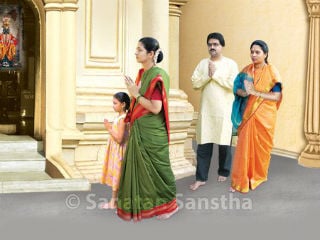 How many pradakshinas (circumambulations) should be performed around a Deity ?
How many pradakshinas (circumambulations) should be performed around a Deity ?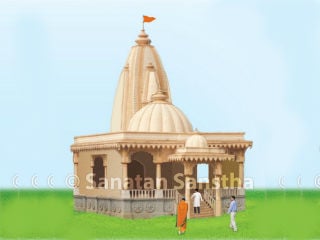 The seven layers in the arrangement of a Devalay (Temple)
The seven layers in the arrangement of a Devalay (Temple)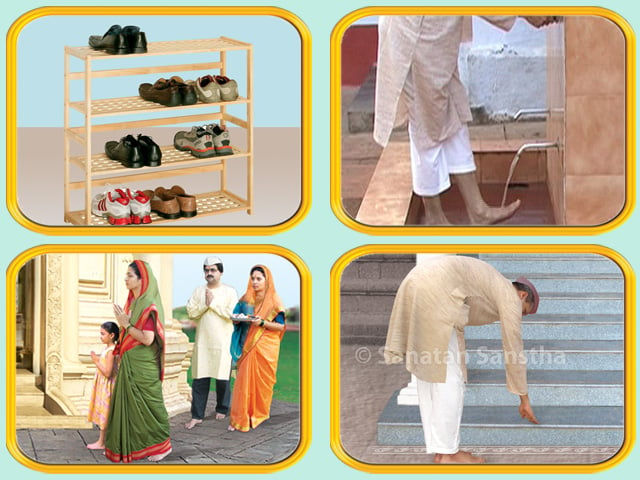 Actions to be performed before entering a Devalay (Temple) and the underlying science
Actions to be performed before entering a Devalay (Temple) and the underlying science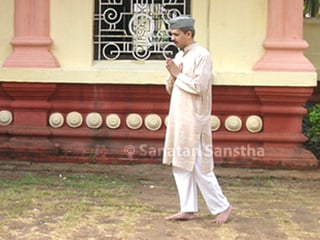 Method of going from the premises towards the sabhamandap of the Devalay (Temple)
Method of going from the premises towards the sabhamandap of the Devalay (Temple)